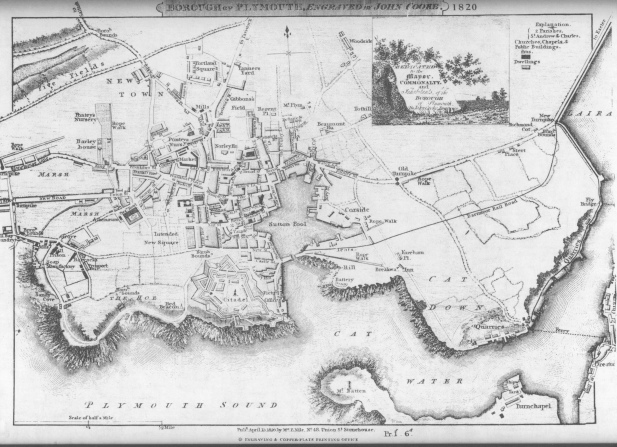
Map of Plymouth (1820)
When our Milligen, Lockyer and Seppings ancestors lived in Plymouth, Devon, it was one of the largest seaports in England. ‘On the west bank was Plymouth Dock, renamed Devonport in 1824, the site of a major naval base and dockyard, which had grown spectacularly during the eighteenth century so that by 1801 its population exceeded that of Plymouth.’ Near the smaller town of Stonehouse were the royal marine barracks, naval hospital and victualling yard. Between 1812 and 1844 the mile-long breakwater was constructed, which created ‘one of the largest and safest harbours in Britain’. (1)
Lockyer – Plymouth

In the late 1700s, the Lockyer family lived in the Island House, on Southside Quay, Plymouth, the stand alone building in the centre of this photo (1890)
Ann Maria Marshall Lockyer was born in Plymouth, Devon, 1782, the fourth of eleven children, named after her mother, Ann Grose. Her father, Thomas Lockyer (b. 1756 Plymouth) was a successful Sailmaker and Ship Riggings Merchant who rented a ‘Plot of ground on which have been erected warehouses’ on Southside Street, Plymouth, ‘Conventionery rent – 1 pound, 5 shillings; 20 pounds fine paid on last renewal 8 Apr 1801’. (2)
He also rented the Island House on Southside Quay, Plymouth, where the family lived. There is a record showing he paid £240 on 23 December 1796 for building and … (possibly adjacent buildings and the lands appropriated to the use of the household).

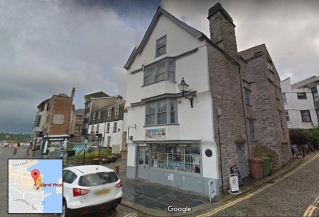


The Island House is one of the principle buildings of historic interest on The Barbican, Plymouth, today.
Island House, No 9 The Barbican, named because it has a road around it, was constructed by Mr Johnathon Sparke and is dated as early as 1572 when the quayside was built. It was one of the houses where the Pilgrim Fathers lodged prior to their final departure for America on September 6th 1620 in the Mayflower. (3) Sir William Molesworth, an heir of Mr Sparke, leased the Island House to the Bayly family who, in 1786, purchased the freehold. It is possible that Thomas Lockyer rented the house from the Bayly family soon after when they moved to a new property further along the Barbican.

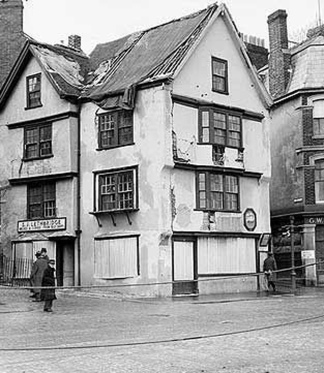
Island House, Plymouth, late 1800s and after the Blitz (1941)
The Elizabethan house survived the destruction of Plymouth in the Blitz, but during an air raid on the night of 13th/14th January, 1941, it sustained considerable damage and was restored in 1948 and again in 1992.

St Andrews Church, Plymouth (1832)
Thomas and Ann Lockyer’s children were all baptised in St Andrews Church, Plymouth. Of the seven boys, one became a mayor of Plymouth, one was the Comptroller of Customs, Plymouth, one became a Captain, one a Brigadier General and two were Majors in the Royal Navy, and one was a solicitor in London. All were married. Ann Maria Marshall Lockyer married Lt John Milligen Seppings at Charles the Martyr, Plymouth, in 1804. Her elder sister had died in infancy but her two younger sisters, Eliza Maria Lockyer (b. 1791), married in 1809 in Wembury to Henry Allworth Meriwether esq. of the Inner Temple, London, an Attorney General and Town Clerk of London, and Jane Edwards Lockyer (b. 1793), married Edward Hobson Vitruvius Lawes esq. of the Inner Temple, London, Barrister at Law, in 1815.
Lockyer – Wembury
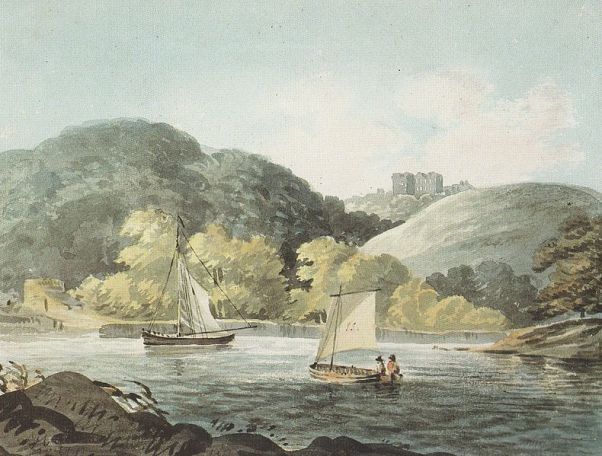
Coastal view of Wembury House ruins high up in the distance. 1797 watercolour by Rev. John Swete
Wembury House
In 1802, Thomas Lockyer bought a property out of Wembury village on the south coast of Devon, close to Plymouth Sound. Wembury is six miles from Plymouth and was an area of ‘medieval manors, open fields, and the emergence of substantial agricultural estates’. (4) With a population of around 400, they were ‘structured in a strict social hierarchy’. A few prominent landowners controlled the estates; beneath them were their tenant farmers and a large agricultural labour community lived in settlements of rented cottages.
In The History of Devonshire Vol 3 (1806) Richard Polwhele writes that Thomas Lockyer paid £26,500 plus £1,500 for the timber at auction for the property which included the ruins of Wembury House, 890 acres, an additional rental manor, and a ‘valuable fishery’. The immense tidal fishpond on the Yealm Estuary, which ‘contrived so as to be stored with fish by the influx of the tide, and closed by the floodgates, which prevented their return to the ocean’ included ‘every sort of fish that frequented the coast’. (5)

‘Wembury Place’ is Wembury House (1809)
The property is described on the Wembury House website as in ‘unspoilt countryside in the South Hams which is designated as an “area of outstanding natural beauty”. Set at the top of a valley it has views down to the Yealm estuary.’ Wembury House has a long and distinguished history dating back to the Augustinian Priory of Plympton, founded in 1121. From the remains of a cell of the priory, the first Wembury House, built by Sir John Hele, was a ‘16th century mansion of legendary grandeur’ and one of the most important houses in the parish. An exceptionally grand multi-storey mansion, it was recorded in the Devon Hearth Tax of 1674 as having 42 hearths – the largest number recorded in any house in Devon. (6)
In 1685, John Pollexfen began to remodel and rebuild the Elizabethan house with ‘elaborate gardens and landscaped parks’ but later generations of his family could not afford to maintain it. John Pollexfen’s granddaughter sold Wembury House in 1757 to Sir William Molesworth who had also owned the Island House in Plymouth where Thomas Lockyer and family lived. By 1797, the diarist John Swete described the manor as ‘in a state of great decay if not entirely dilapidated’. Sir William Molesworth’s daughter was the heiress to his estates and married Earl Camden who sold the Wembury House property to Thomas Lockyer in 1802.
In 1803, the recently retired Merchant decided to demolish the ruin and start again. Polwhele recorded the disposal and removal of materials which Thomas sold for eight hundred pounds, including the gilded sash window frames and the Portland stone facing to the walls (possibly reused in Traine Farm). The Barton Farm, in front of the ruin, was also demolished and landscaped as a park. He then built the present Old Barton Farm and New Barton Farms, splitting the land between them. A member of the Wembury Local History Society, Robert Rowland from Traine Farm explained, ‘A Barton was originally a large farm that grew barley ie Barleytown or barleyton. Wembury Barton was about 400 acres so Thomas made two farms of it and built the farmhouses and barns accordingly. There is an L for Lockyer in the centre of the front wall of one of the barns at Old Barton.’
The Devon Rural Archive describes the late Georgian Manor House built for Thomas Lockyer between 1803 and 1806 as ‘on the lower terrace of a split-level site on a very exposed hilltop site, evidently chosen for its wide views … A large walled area to the west, apparently belonging to the late C16 period encloses a garden of varying levels with a gently sloping central lawn, scarped away to the present house. A raised buttressed terrace at its west end was crenellated and seems to have formed part of a formal garden associated with Sir Hele’s mansion. Flanking walls and tree belts protect the house and its gardens from westerly winds, with a small gothic lodge to the north. Many architectural fragments of the earlier houses are built into these walls. Large walled gardens lie in the valley to the east, at the foot of which is the large tidal fishpond.’ There are several outbuildings including gardeners’ bothy, stables and associated buildings, an orangery and well-house. An earthwork Rampart, or raised terrace, located across the lawn in front of the present house are surviving remains from Sir John Hele’s 16th century house, as are the kitchen garden, conservatory and a pavilion.
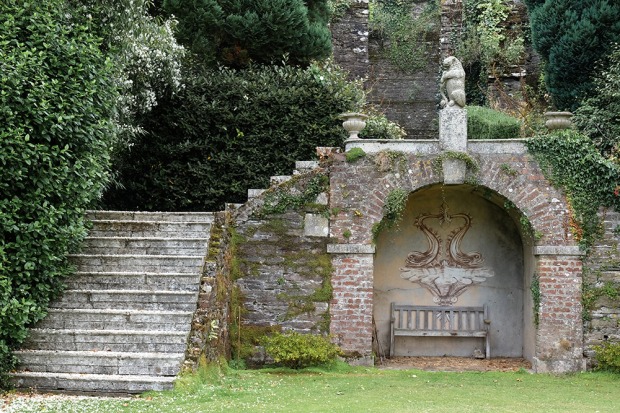
Steps to Ramparts, Wembury House. An archway beneath the central steps of the terrace, now walled up, is said to have led to the sea via an underground passage.
Thomas Lockyer’s Wembury House is of national importance. In the Wembury Heritage Data Base, it has two storeys plus attic and basement, built of rubble with ashlar dressing, a slate hipped roof, and rusticated quoins. There is also a Tuscan porch with cast-iron balcony. It has a Grade II National Heritage Listing for the building, garden boundary walls and two pairs of gate piers north-west and south-east, two pairs of gate piers and link walls 230 metres north-north-east, kitchen garden walls built of stone rubble and gate piers with moulded caps and ball finials and ornamental wrought iron gates, thirteen buttresses on the outer wall terrace, steps on leading down to lawn and more buttresses at the sides.
 Wembury House
Wembury House
On 9 Aug 1806, Thomas Lockyer died after being thrown out of his carriage and the wheel rolling over his leg which became gangrenous. He was buried on 15 August in the floor of the North aisle of St Werburgh’s Church, Wembury. Thomas’s death led to the manor being advertised for sale in Trewman’s Exeter Flying Post on the 14 July 1808, with the land increased to 946 acres. It was described as including ‘a new-built mansion house, with lawn in front, a coach-house and suitable stabling … a bowling green, and a most elegant vinery and plant-house … Also, the Ferriage or Passage over the Haven and River of Yealme, called Shepeing Ferry, with the Tolls and Dues of the said River, and the Water, Piscary, Fishing, Oysterage, and Royalty of, in, and through the same’.
According to Faith Packard in Our Family History, Edmund Henry Seppings was brought up by his grandmother, Ann Lockyer, in Wembury, and kept his cousin, William (Edmund Lockyer’s first born), a year younger, company. Edmund and William also spent time together in Australia in the early 1840s.

Wembury House – see www.wembury.com for more interior photos
On 23 June 1809, a document was drawn up to enable partial sale of the estate to Thomas’ brother, William Lockyer of Plymouth, merchant. The sale included West Wembury farm – a large farmhouse built of slate rubble with granite quoins and slate hung front; slate roof with gabled ends, (Rider’s, Hercules’ and Willing’s tenements) Lye’s or Warren’s, Luke’s, Witherage’s, and Nicholas’s tenements, Kelly’s Garden and Furze Park, Wembury Mill, cottages and gardens, Rowe’s, Prinn’s and Tregosses’s tenements, North Ditch and Good House or Kimber’s tenement, Saffron Park, Higher and Lower Church Park, the Old Inn public house, Freesland and Wood Park in Wembury.
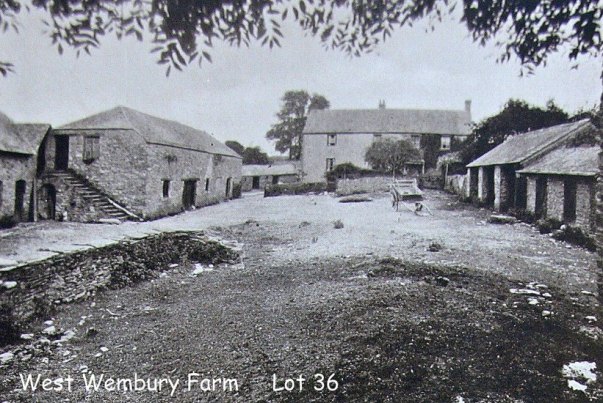
West Wembury Farm (late 18th century)
‘Thomas junior was in need of funds to complete the building work on the house etc. and to fulfill the terms of his Father’s Will. In those days they could not just sell the freehold, they had to do something called Lease and Release in two documents,’ explains Robert Rowland. The Lease was 25 shillings and one peppercorn! Listed on the document in The National Archives are Thomas’ brother Edmund Lockyer of Plymouth, esq, John Harris the younger of Radford, Plymstock, esq, Samuel Wroth of Modbury, maltster, Henry Rivers the younger of Stowford, gent, and Thomas Lockyer (junior) of Wembury House, Wembury, esq, who would have been the executors of Thomas senior’s Will. (7)
‘It is a bit confusing as to which Edmund, William or Thomas they refer as the names occur in both generations. Edmund 1782-1816 was a very important figure in Plymouth so would have taken the lead as head of the family.’
On 26 May 1814, the manor was again offered for sale in Trewman’s Exeter Flying Post, reduced to 550 acres. ‘All the doors of the sitting and best bedrooms, 24 in number, are made of a very beautiful Spanish mahogany’ while to the rear was ‘a mount or terrace, about 300 feet in length, 30 feet wide and 30 feet high, commanding extensive views of the ocean’. The Calmadys bought West Wembury from William Lockyer in 1814, extending the Langdon Estate, but the manor house was not sold until 1822, following the death of Thomas Lockyer’s wife, Ann, in December 1820, to the diplomat Sir Edward Thornton. (8)
Thorn House (South Wembury House/Lockyers Cottage)

A 1914 postcard of Thorn House, on the left, and in the mid ground, on the river bank, Fishpond Cottage and Boathouse Cottage, above them is one of the walled gardens and above that, the stables.
It is possible the Lockyer family lived at Lockyers Cottage while the new Wembury House was being built. Wembury Local History Society member, Robert Rowland, wrote, ‘Lockyers Cottage has had several different names – South Wembury House, South Wembury Court, and now Thorn. It was originally the gate house to the first Wembury House built by Sir John Hele. It is situated by the River Yealm as everything in the early days came via the river. In the Hearth Tax returns of 1662 it was recorded as having 13 fire hearths, quite a substantial property, as most people had one or two. Wembury House was sold off, but the family kept the estate and moved permanently to Lockyers Cottage.’
After Thomas Lockyer’s death, his son, Thomas, moved into what became the new manor house, South Wembury House, overlooking the Yealm, and soon afterwards 536 acres were transfered from the ‘Manor of Wembury’. (9) According to A.G. Collings in A Wembury History – Medieval to Modern, ‘Lockyer’s Cottage’ on the tithe map was depicted as a small structure, but was to be considerably extended by the 1860s. The building was by then the very imposing ‘South Wembury House’ with garden buildings to north and south.’
On the Thorn House and Garden website, it says ‘the exact date of the present house is unknown, however it is on the site of an earlier building which goes back centuries as evidenced by the existence of Tudor cellars. South Wembury House was refurbished in the early 19th century by Thomas Lockyer.’
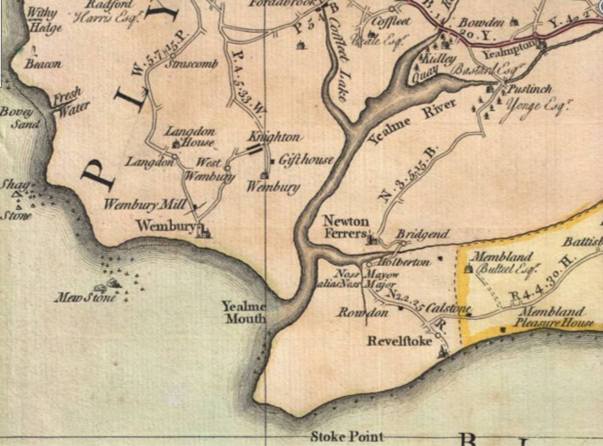
The ‘Gifthouse’ was the Hele Almshouses. ‘Wembury’ is Wembury House. The other buildings shown are St Werburgh’s Church and Langdon House (1765)
Sir Warwick Hele of Wembury, in his will of 1625, established a charity which ‘appointed and ordained 10 poor people to be kept and maintained in his alms house at Wembury for ever, to be chosen and appointed by him that should be owner of South Wembury House’. (10) In 1806, when Thomas Lockyer succeeded his father in South Wembury estate, there were nine women in the almshouse. In 1812, according to The Charities in the County of Devon, ‘the buildings being in a very dilapidated state, it became necessary to lay out a considerable sum upon them; whereupon Mr. Lockyer, the owner of South Wembury House, advanced the ‘money required, without interest, intending to reimburse himself out of savings arising from vacancies among the alms-people, without discharging any, or stopping their allowances. He has also, at various times, permitted his own materials to be used in the buildings. From his account it appears, that the sum expended in repairs since 1808, amounts to 67 l. 9s. 2; d. The alms people consist of women who are old and very poor … and we are told by Mr. Lockyer, that he proposes to select such poor old persons, of either sex. The alms-people are each paid, quarterly, 15s.’
The Ecclesiastical Chapel at Hele Almshouses in the centre of a row of six rubblestone Residential Hele Almshouses (Listed) were built close to Wembury House by Sir Warwick Hele circa 1590 and are still in use.
The road to Wembury House is described in The Tourists Companion Being a Guide to Plymouth, 1823, as ‘the elegant modern residence of Thomas Lockyer, Esq. commanding extensive prospects over the fertile districts along the banks of the Yealm.’ It then takes us on a short walk ‘to the mouth of that river, where we cross to Newton Ferrers, by the help of a ferry-boat. This village, whose pleasing and salubrious situation renders it a favourite retirement for naval officers, is placed on the banks of the estuary.’
‘The 1851 census confirms the presence of high-status residences in the parish,’ writes A. G. Gollings. ‘Charles Calmady at Langdon Hall farmed 850 acres, while Sir Edward Thornton still occupied Wembury House and Thomas Lockyer occupied South Wembury House’ and owned the Old and New Bartons.
 South Wembury House (now Thorn House)
South Wembury House (now Thorn House)
The Thorn House and Garden website reveals, ‘In 1876 Richard Cory, a wealthy London coal merchant, bought the South Wembury estate from the Lockyers. The Cory’s added a ballroom and billiard room; guests included the Prince of Wales and his brother the Duke of Edinburgh. In 1920 the house was sold to William Arkwright, who renamed it ‘Thorn’.’ He developed terraces and formal grounds in imitation of those at Sutton Scarsdale. The next owner, the Hon. Mrs Ida Marie Sebag-Montefiore, an enthusiastic horticulturalist, added more. When she left Thorn in 1938, she gave some of the land to the National Trust and the estate was gradually broken up into smaller units. John and Eva Gibson have lived at Thorn since 1981.

St Werburgh’s church, Wembury (1943)
Thomas and Ann Lockyer, and their son Thomas and his wife Jane Lockyer are buried in St Werburgh’s church, Wembury, and commemorated on wall plaques. The Parish Church, overlooking Wembury Beach, is Grade 1 listed and dates from at least the 14th century.
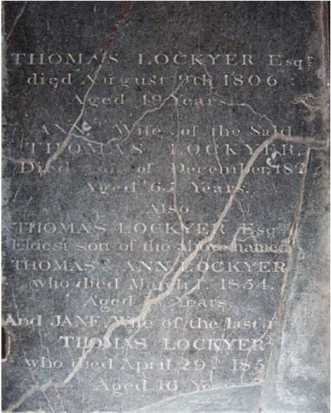

Lockyer memorial ledger inside St Werburgh’s church, Wembury, North Aisle
Transcription –
THOMAS LOCKYER ESQ died August 9th 1806 Aged 49 Years
ANN wife of the Said THOMAS LOCKYER Died 8th of December 1820 Aged 65 Years Also THOMAS LOCKYER ESQ Eldest son of the above named THOMAS & ANN LOCKYER who died April 29th 1859 Aged 76 Years
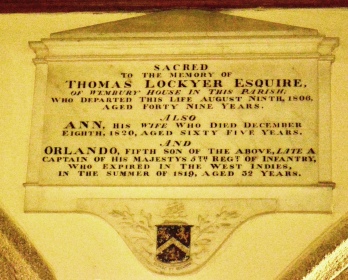

Lockyer memorial wall plaques inside St Werburgh’s church, Wembury
Major Edmund Lockyer, the third son of Thomas and Ann, was famous for raising the British flag in Albany, Western Australia, on 21st January 1827 and claiming it for the Crown. In the south aisle of St Werburgh’s church is an Australian flag and Western Australian flag. The WA flag was presented to St Werburgh’s in 1941 by the Australian Government to commemorate Edmund Lockyer’s deed. The Australian flag was presented to the church in 1979. Edmund Lockyer’s first son, William, was christened at Wembury House in 1808.


In the south aisle of St Werburgh’s church is a plaque and a Western Australian flag commemorating Major Edmund Lockyer.
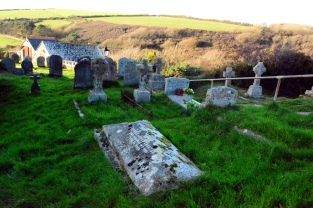
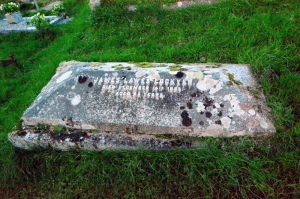
In the old yard of St Werburgh’s church is Thomas and Jane Lockyer’s youngest son James Lawes Lockyer’s grave.
Members of Thomas Lockyer’s family were Mayors of Plymouth on 9 occasions.
Thomas’ brother Edmund Lockyer was a prominent lawyer in Plymouth and was responsible for building the Royal Theatre and the Plymouth Atheneum in ‘grand Palladian style,’ but it was all lost in WW2. (11) The Lockyer’s are remembered in Plymouth with Lockyer Street, Lockyer Court, Lockyer Road, Lockyers Quay, the once Lockyer Hospital, Lockyers Quay Pub Restaurant and Lockyer House B & B.


Wembury House, Thorn House and the River Yealm, Wembury
Photo & Illustration Credits –
‘Map of Plymouth, Devon’ Engraved by John Cooke (1820)
‘Southside Quay, Plymouth’ (1890) www.pinsdaddy.com/old-photos-of-plymouth-uk
Google Maps Images – Island House, The Barbican, Plymouth
‘Island House, Plymouth, late 1800s’ www.visitthepast.co.uk
‘Island House, Plymouth, after the Blitz’ (1941) www.pinterest.com
‘St Andrews Church, Plymouth’ hand-painted steel engraving drawn by Thomas Allom and engraved by Wallis for “Devonshire Illustrated” (1832)
‘Wembury’ watercolour by Rev. John Swete (1797) – Devon Record Office
Wembury map (1809) Ordinance Survey First Series, Sheet 24
‘Steps to Ramparts, Wembury House’ www.wembury.com
‘Wembury House’ photograph by Robert Rowland, Traine Farm – Wembury Local History Society
Wembury House photos – www.wembury.com
‘West Wembury Farm late 18th century’ Wembury Local History Society
‘South Wembury’ postcard (1914)
Benjamin Donn’s map of Devon (1765 ) www.geographicus.com
‘South Wembury House’ (now Thorn House) thornhouse.co.uk/history
‘St Werburgh’s church, Wembury (1943)’ Wembury Local History Society
‘Lockyer memorial ledger’ photograph by Wembury Local History Society
‘Inside St Werburgh’s church, Wembury’ photograph by Sue Carlyon, Wembury Local History Society (2017)
‘Lockyer memorial wall plaques’ photographs by Sue Carlyon, Wembury Local History Society (2017)
‘Plaque commemorating Major Edmund Lockyer’ photograph by Sue Carlyon, Wembury Local History Society (2017)
‘Western Australian flag’ photo by Sue Carlyon, Wembury Local History Society (2017)
‘James Lawes Lockyer’s grave’ two photos by Sue Carlyon, Wembury Local History Society (2017)
‘Wembury House, Thorn House and the River Yealm’ (1946) photograph – Wembury Local History Society
‘Thorn House and the River Yealm, Wembury’ photograph thornhouse.co.uk
Research Resources
http://wemburyhistory.org.uk/
Wembury Local History Society –
Sue Carlyon and Peter Lugar, Wembury, Devon
Robert & Sheila Rowland Traine Farm, Wembury, Devon
http://wemburyhistory.org.uk/wp-content/uploads/2013/03/A-Wembury-History.pdf
http://wemburyhistory.org.uk/2013/05/wembury-house-4/
http://wemburyhistory.org.uk/aboutwembury/agriculture-rural-society/
http://wemburyhistory.org.uk/wp-content/uploads/2016/04/Wemburys-Listed-Buildings-2016.pdf
http://wemburyhistory.org.uk/wp-content/uploads/2013/03/Wembury-Heritage-Database-maps.pdf
http://wemburyhistory.org.uk/wp-content/uploads/2014/02/Wembury-Heritage-Database.pdf
(1) Brian Moseley, Plymouth
http://www.oldplymouth.uk/Barbican%20(The)-09-Island%20House.htm
(2) The Charities in the County of Devon 1839 James Newman, London
Great Britain. Commissioners for Inquiring Concerning Charities
(3) Brian Moseley, Plymouth
http://www.oldplymouth.uk/Barbican%20(The)-09-Island%20House.htm
(4) Wembury Local History Society
http://wemburyhistory.org.uk/aboutwembury/agriculture-rural-society/
(5) The Reverend Daniel Lysons, Topographical and Historical Account of Devonshire, London, 1822, p.549
Wembury House, Devon: ‘a house of legendary grandeur’.
https://www.thefreelibrary.com/Wembury+House%2C+Devon%3A+%27a+house+of+legendary+grandeur%27.-a0107277545
(6) T.L. Stoate, Devon Hearth Tax Returns 1674, Bristol, 1982, p. IX.
http://www.devonruralarchive.com/Wembury.html
(7) Wembury Deeds (Ref 447) http://discovery.nationalarchives.gov.uk/
(8) Mills, J., Rowland, R. & M., & Broughton, P. 2000 Wembury at the First Millennium: A Description of the Domesday Manors of Wembury Parish in Devonshire p 21
(9) 19th Century Thorn http://thornhouse.co.uk/history.html
(10) The Charities in the County of Devon 1839 James Newman, London
Great Britain. Commissioners for Inquiring Concerning Charities
(11) Wembury Local History Society member, Robert Rowland.
Richard Polwhele, The History of Devonshire (3 vols, 1797-1806)
A genealogical and heraldic history of the extinct and dormant baronetcies of England By John Burke 1 January 1838
The History of Parliament: the House of Commons 1820-1832, ed. D.R. Fisher, 2009 Available from Cambridge University Press
The Tourists Companion Being a Guide to Plymouth
The_Tourist_s_Companion_Being_a_Guide_to (Plymouth) pdf
A Wembury History – Medieval to Modern A.G. Collings with contributions by members of Wembury Local History Society
Pigot’s Commercial Dir. (1830), 228-30; White’s Devon Dir. (1850), 632-63, 689-91, 696-703; PP (1835), xxiii. 595-6; W. Hoskins, Devon, 208-10, 213-14, 453-60; C. Gill, Plymouth, 77-171.
http://www.visionofbritain.org.uk/maps/
Devon Gardens Trust
http://www.parksandgardens.org/places-and-people/site/4406?preview=1
http://www.historyofparliamentonline.org/volume/1820-1832/constituencies/plymouth
https://someolddevonchurches.wordpress.com/2016/05/02/st-werburghs-church-wembury/






Hi Katherine,
Such extensive research. It must have taken many months to put this together. Well done. I am going to visit my fathers niece in Melb. who we have only recently made contact with. I haven’t progressed with the Purtells, but i’m hoping Marie (Purtell) Connolly will be able to fill in some more details for me.
Thanks for sending this history to me.
Love Louise.
LikeLiked by 1 person
Yes, Louise, it took me months of research and putting it all together. I love the discovering and learning, and I especially enjoyed learning about the Lockyers and Wembury House from the wonderful people of the Wembury Local History Society, and then being able to share what I found. All the best with finding more details about the Purtells. Love, Katherine
LikeLike
Dear Katherine,
Robert Rowland informed me of your wonderful work! I, too, am a direct descendant from Thomas Lockyer and Anne Grose. I have a family tree which I have continued from the Wembury History Society’s one to present day but only of my family’s direct line. I would love to buy your book, how do I do that? I live in Hertfordshire, England. Hope to hear from you, best wishes Val Gaubert
LikeLiked by 1 person
Hi Valerie, I just discovered your comment! The book is still a way off being published as i’m still writing it! Thanks for contacting me. I’ll be in touch. Katherine
LikeLike
Hi Katherine, I’ve just come across your wonderful Family History site! Haven’t done more than scan the Lockyer page as yet but I’m looking forward to reading through all this information. I’m a direct descendant of Maj Edmund Lockyer and his second wife Sarah Morris. What a truly interesting family! Going to get myself a cup of coffee and have a good read. Cheers, Chris
LikeLiked by 1 person
Hi Christine, I’m glad you found the website and hope you’re enjoying the information. Yes, the Lockyers are a really interesting family. I am descended from the Major’s older sister, Ann Maria Marshall Lockyer who married Lt John Milligen Seppings. I’m currently writing the next blog post which is about the Milligen, Seppings and Lockyer Military Men in the Age of Sail. I’m creating brief profiles of Major Edmund Lockyer and his brothers and relevant sons for the blog post and later I will extend these with more detailed stories of their incredible journeys into individual profile pages. If you ‘follow’ this website you will receive an email notification when it’s posted. Thanks, Katherine
LikeLike
Dear Chris,
We are also descendants of Major Edmund Lockyer and Sarah Morris through Emily who married Capt. George Thomas Potter – our mother was a Potter.
We are also fascinated by this page and all of the information we have recently uncovered through FamilySearch.org Thanks to Katherine for her treasure trove of information.
We have just set up a Facebook group “Descendants of Major Edmund Lockyer” if you wish to join. I’m looking forward to connecting with you. Regards, Gabrielle.
LikeLiked by 1 person
Hi Katherine,
Thankyou for your detailed history of the Lockyers which I have only just discovered. I started research my husband’s grandmothers Lockyer family just yesterday and was amazed at the rich amount of information available. Leslie Rivett, my husband is a descendant of Major Edmund Lockyer (via Charles Weedon, then Henry Edmund and then his daughter Lilly Lockyer. I look forward to reading more from you.
Kind Regards,
Annesley Watson
LikeLiked by 1 person
Hi Annesley,
I’ve not visited Katherine’s site for a while and very happy that your comment prompted me to take another look. My 3 x great grandfather was Major Edmund Lockyer. I’m descended from his son Frederick MacDonald Lockyer, then Emily Amelia Lockyer. The information Katherine has put together on this site is indeed wonderful to read.
Cheers,
Christine Tuita
LikeLiked by 1 person
Pingback: The Lady Ann ship, and James B Wilcox, emigration agent, Barbican, Plymouth. – Hapgoods from Marksbury
H Katherine,
Thanks for this wonderful information about the Lockyer family. Major Edmund Lockyer was my 4th Great Grandfather and I’m descended from his daughter Emily who married Capt. George Potter. My mother was a Potter, and I recently discovered this connection through FamilySearch.org. I am amazed by our heritage, as many of these connections were not passed down.
Best regards,
Gabrielle (Sydney, AUS)
LikeLiked by 1 person